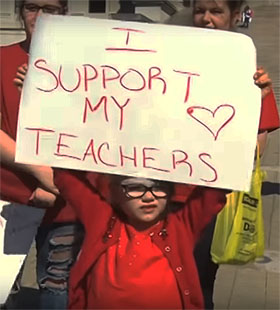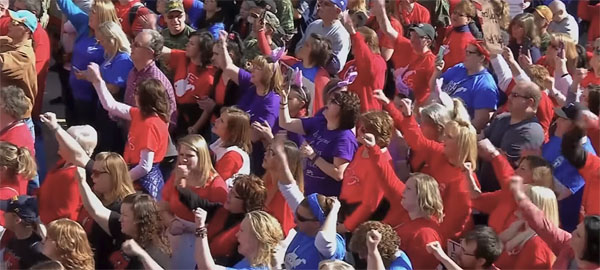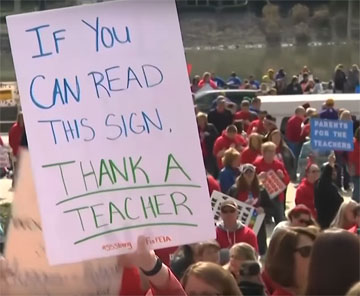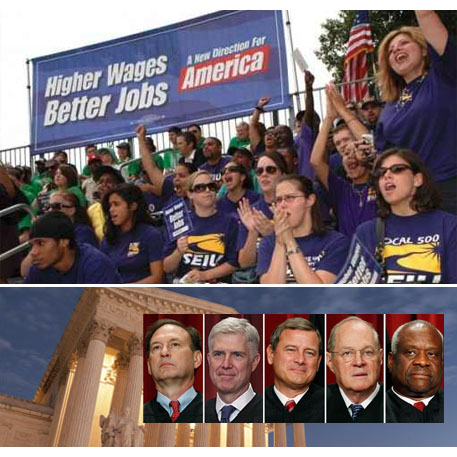OPINION
The way forward for a new labor movement
West Virginia teachers’ strike—a win for all workers—is our answer to Janus

By JONATHAN ROSENBLUM
(March 15, 2018) — The story out of West Virginia in the last three weeks is nothing short of amazing.
Some 35,000 teachers, janitors, cooks, bus drivers, and other rank-and-file school workers, who are already living in the post-Janus world, took on state power, defied laws that forbade strikes, rejected half-measures offered by the political establishment (and initially backed by their union leaders), and delivered a stunning victory not just for themselves, not just for all West Virginia state workers, but for workers everywhere.
Against all of the pundits’ predictions, they struck for 9 days, won 5 percent pay raises, and secured a reprieve on rising healthcare costs – for themselves and also for thousands of other public workers. And, significantly, at the same time they defeated efforts to privatize schools and undermine basic workers’ rights.
 It wasn’t just the educators – overwhelmingly women – who stepped up. More than 1,000 students rallied in solidarity with the strikers – a statewide march organized by rural students. Strikers delivered meals to families whose children were dependent on food in shuttered school cafeterias, and teachers met with students preparing for college entry tests. Parents opened up their homes to kids to keep them engaged and learning during the strike. And of course, thousands rallied at the state capitol, forming a sea of red shirts. When the political leaders announced a settlement, the strikers refused to leave until the agreement was sealed in writing.
It wasn’t just the educators – overwhelmingly women – who stepped up. More than 1,000 students rallied in solidarity with the strikers – a statewide march organized by rural students. Strikers delivered meals to families whose children were dependent on food in shuttered school cafeterias, and teachers met with students preparing for college entry tests. Parents opened up their homes to kids to keep them engaged and learning during the strike. And of course, thousands rallied at the state capitol, forming a sea of red shirts. When the political leaders announced a settlement, the strikers refused to leave until the agreement was sealed in writing.
The West Virginia educators, who just six weeks ago were belittled by their billionaire governor as “dumb bunnies,” began raising basic questions, not just about education funding but about the priorities of the state, specifically tax breaks handed to the gas and coal companies that have plundered their communities and polluted the environment.
An uprising from below against the 1 percent
For many years, West Virginia has had a 1 percenter’s dream government. State leaders – both Democrats and Republicans – repeatedly have cut corporate taxes in the last decade, costing state government $425 million each year. Public services have been slashed while workers have been called on to make do with less. Gas, oil, and coal companies (largely non-union) secured generous tax breaks. And two years ago state legislators attacked unions by passing a right-to-work-for-less law, trying to extinguish the region’s militant coal miner past.
All that brought things to a boiling point for West Virginia educators, among the lowest paid in the country. Yet the strike was very much an uprising from below, not a strategic move designed in union headquarters.

Rising healthcare costs and the governor’s decision to confer a measly 1 percent raise led to flareups of worker anger in January – walkouts in a few school districts. With no collective bargaining, the workers’ recourse was to lobby the government. The call for statewide action exploded as workers confronted political indifference at the state Capitol in Charleston.
“I live paycheck to paycheck,” high school English teacher Katie Endicott told the New York Times. “When I realized that they were taking hundreds of dollars and then they tried to tell me they were giving me a pay raise of 1 percent, I knew I can’t just sit back. I can’t be complacent, something has to change.
“We went to the Capitol on Feb. 2, we stood in solidarity, and they would not talk to us,” Endicott recalled. “When we walked out of there, my husband looked at me and he said, ‘I feel so defeated.’ They didn’t listen to anything that we had to say. We were just walking silently from the Capitol and one teacher said, ‘Guys, we’re really going to have to strike.’ At that point, I knew.”

Teachers and other school workers voted overwhelmingly in mid-February to walk out, and on Feb. 22 workers in all 55 counties struck. It was an unlawful action, but no matter: “People are starting to get angrier and remember our history, remember our roots,” middle school special education teacher Jenny Craig said, recalling the state’s militant coal miner organizing history.
After four days of closed schools in all 55 counties, the governor and union leaders announced a verbal agreement on a 5 percent raise for school staff and 3 percent for other state workers. They declared the strike settled.
Not so fast, said the workers. At the announcement outside the Capitol building, middle school teacher Jay O’Neal said, “Teachers in the crowd started interrupting and yelling at our leaders: ‘We’re not going back in for that!’ Everyone started chanting, ‘We are the union bosses! We are the union bosses!’ and ‘Back to the table! Back to the table!’”
It was an outstanding display of union democracy. “Strikers now have a sense of our power, and we don’t want to back down,” O’Neal said.
The strike held strong statewide, forcing a crisis in state government that only ended when the legislature and governor agreed on a 5 percent raise – not just for educators, but for all state employees. And even then, the strikers refused to leave the Capitol until the legislation was signed.
The answer to Janus
 Union leaders and activists around the country have spent a lot of energy in recent months debating and preparing for the expected Supreme Court decision in Janus vs. AFSCME, which will mandate open shops – freeloading rights – throughout public sector workplaces in the U.S.
Union leaders and activists around the country have spent a lot of energy in recent months debating and preparing for the expected Supreme Court decision in Janus vs. AFSCME, which will mandate open shops – freeloading rights – throughout public sector workplaces in the U.S.
For everyone wondering how we fight back in the age of Janus, the West Virginia strikers have provided a powerful answer: not by hunkering down and caring only about dues-paying members, not by half-measures or cutting deals with politicians or corporate powers, but through grassroots, democratic, militant unionism that embraces the entire community. It’s a unionism that concerns itself not just with wages and hours and union contracts but with basic questions of social priorities and how we unite in a movement to fight for them.
The West Virginia win points to a fresh way of thinking about the future of the U.S. labor movement – a social justice union, also referred to as social movement unionism. We’ve seen glimpses of this form of unionism in recent years: The Chicago teachers strike to defend public education, fast food workers and others staging walkouts and civil disobedience under the Fight for $15 banner, and strikes by nurses for quality patient care, among other examples.
Social justice unionism is not simply mobilizing members better and building community alliances. It explicitly aims to build working-class power to advance the rights of all working people – wage earners, the unemployed, the precariously employed, students, retirees, and unwaged workers such as caregivers. It recognizes that our interests are fundamentally opposed to the interests of the political and economic elites who control the economy. Social justice unionism unites unions and community groups as equal partners with other organizations fighting oppression – immigrant rights groups, faith communities, civil rights organizations, LGBT groups, racial justice groups, etc. – in a broader labor movement of the 99 percent.
Social justice unionism is not a new concept. It’s been practiced in places around the world, mostly in the global south, where workers have long been forced to struggle against the twin tyrannies of imposed neoliberalism and severe political repression. Black industrial and mining workers, under the banner of the Congress of South African Trade Unions, extended the concept of the workplace strike to society at large, helping to bring down apartheid. Filipino workers waged community-wide “strikes of the people” to protest everything from rising fuel prices to the Marcos dictatorship. Young Brazilian workers in emerging privatized industries have formed unions that blend workplace and community struggles seamlessly, elevating issues like the rights of sexual minorities and working-class cultural expression along with better wages and other working conditions.
What’s common to these movements is an expansive definition of “the union,” a commitment to build broad alliances, an unflinching commitment to internal democracy, and a readiness to challenge the assumptions of capitalism and advance an alternative vision of society.
The 2018 West Virginia strike traces that same radical lineage, drawing inspiration from battles to organize the state’s coalfields 100 years ago. Closer to home, we have similar inspirational examples, such as the Sakuma farmworkers and allies who led strikes and boycotts to win a breakthrough union contract in the fields of northwest Washington. There’s the emerging Poor People’s Campaign: A National Call for Moral Revival, a visionary movement of “fusion politics” that is uniting grassroots faith, labor, LGBT, immigrant justice activists in a bold call for economic transformation of our country. And I’ve written about this new form of unionism in “Beyond $15: Immigrant Workers, Faith Activists, and the Revival of the Labor Movement,” the story of how a remarkable group of workers and community members made history in SeaTac in 2013 with the first successful ballot fight for $15 and worker rights.
For a working class battered by decades of neoliberal austerity, union-busting, and now Trumpism, these and other examples of social justice unionism illuminate a way forward.
“For a successful mass movement, people don’t have to agree on partisan politics, on religion, or anything else for that matter,” observed striking West Virginia teacher Emily Comer. “But they do have come together and fight in solidarity around a shared issue. We’ve learned that people will push the other differences aside in the name of solidarity.”
Labor’s anti-PATCO moment
 Many of us recall how Ronald Reagan’s busting of the air traffic controllers union, PATCO, in 1981 was such a defining moment in labor history and in the psyches of workers and bosses everywhere. The defeat and sudden firing of 11,000 union members demoralized workers while emboldening CEOs. It opened the floodgates to rounds of concessions bargaining and union-busting throughout the economy. After 1981, in virtually any workplace, to stop a union drive bosses only had to utter the name “PATCO.” Everyone understood clearly what that meant.
Many of us recall how Ronald Reagan’s busting of the air traffic controllers union, PATCO, in 1981 was such a defining moment in labor history and in the psyches of workers and bosses everywhere. The defeat and sudden firing of 11,000 union members demoralized workers while emboldening CEOs. It opened the floodgates to rounds of concessions bargaining and union-busting throughout the economy. After 1981, in virtually any workplace, to stop a union drive bosses only had to utter the name “PATCO.” Everyone understood clearly what that meant.
Conversely, West Virginia in 2018 offers all of us an anti-PATCO moment – an historical inflection point, a moment when workers and their unions, besieged by rampant corporate greed, beaten down by decades of austerity, and stripped of legal rights, showed us how to fight back and win. Now, workers in Oklahoma, Kentucky, Arizona and elsewhere are talking about following the example of their Mountain State sisters and brothers.
The question for all of us is what we do with the heroism of the West Virginia workers: Whether we will look back in years to come at the remarkable strike and regard it as a minor aberration in the long death spiral of our labor movement, or whether we’ll recall it as our own anti-PATCO moment, the time when the tide began to turn, the strike that gave voice and hope to millions, the moment of uprising that opened our eyes to the great possibilities that exist in a reimagined labor movement.
 Jonathan Rosenblum is a writer and union and community organizer based in Seattle, WA. He is the author of “Beyond $15: Immigrant Workers, Faith Activists, and the Revival of the Labor Movement” (Beacon Press, 2017), and a member of the National Writers Union/UAW 1981. Find him online at https://jonathanrosenblum.org/ or Twitter @jonathan4212.
Jonathan Rosenblum is a writer and union and community organizer based in Seattle, WA. He is the author of “Beyond $15: Immigrant Workers, Faith Activists, and the Revival of the Labor Movement” (Beacon Press, 2017), and a member of the National Writers Union/UAW 1981. Find him online at https://jonathanrosenblum.org/ or Twitter @jonathan4212.





